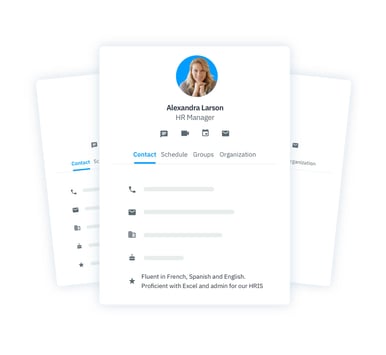By 2025, an estimated 36.2 million U.S. employees will be working remotely.
With video conferencing tools, messaging apps, and cloud-based document management platforms, physical offices are no longer a necessity for many types of collaborative work. But remote work does present some challenges that business leaders will need to solve.
A CNN report in 2020 noted that loneliness and feelings of isolation can have a negative impact on remote workers, as well as productivity. Business leaders are increasingly thinking about how they can use technology to help employees feel more connected, and social intranet platforms could be the solution.
In this post, we’ll look at the benefits of social intranet, what to look for when choosing a social intranet platform, and how one company has used social intranet to engage its 11,000+ employees around the world.
What is an intranet?
An intranet is a private internal network that a company uses to support its work. Companies may use an intranet to store and share files, make company announcements, provide a company directory, and promote collaboration, in general.
Intranet systems have existed since the late 1990s, but legacy systems often don’t support the needs of today’s workforce. With more people working remotely full-time, an intranet platform should offer features that help employees feel engaged and connected.
What is a social intranet?
Traditional intranet platforms typically presented information without allowing for much (or any) employee interaction or feedback. Social intranet software invites employees to get involved. The key features of social intranet platforms are:
Contribution
This means that employees can interact with intranet content in some way — for example, using emoji to react to posts, or commenting on a thread within the platform
Connection
This means that employees don’t just access information via a social intranet, they see who shared the information. Ideally, a social intranet allows users to add a profile picture, which can help employees feel more connected, even if they don’t personally know each other.
Benefits of social intranet platforms
Social intranet platforms offer several benefits, and they can be customized to suit the needs of different types of teams. These are some of the ways companies benefit from using a social intranet:
Improved knowledge sharing
A social intranet platform allows employees and management to share important information, such as company policies, creative documents, and announcements. And with Google Workspace and Microsoft Office integration, a social intranet allows businesses to embed external documents and files.
Better collaboration
With a social intranet, teams can work on the same document simultaneously, even when they’re working remotely. That ensures that everyone is (literally) on the same page and reduces the incidence of duplicate files.
Cross-departmental communication also improves when using a social intranet. Information can be shared with individuals, departments, or with the entire organization, and users can add comments and feedback.
Positive company culture
As we mentioned earlier, loneliness and isolation can have a negative impact on employee happiness and productivity, and a social intranet is one tool for helping employees feel like part of the team, rather than solo contributors.
Odds are, remote employees are already using social media to stay connected to friends and family. A social intranet serves the same purpose, in a business context.
Keep in mind that upper-level management can use a social intranet to share and comment on content, which can help employees view leadership as more accessible.
Higher engagement
When employees feel engaged, they’re more invested in their jobs. So social intranet platforms could help reduce employee turnover.
Social intranet platforms include analytics that reveal how engaged employees are. With that information, managers can identify top-performing content and the types of posts that employees most often interact with.
Increased efficiency
Many businesses lose valuable hours to back-and-forth communication, especially when one person is attempting to schedule a meeting involving multiple people across different time zones. Social intranet platforms allow users to easily schedule meetings, based on everyone’s shared calendars.
These platforms also boost efficiency with a robust search function — users can easily find files, people, and discussions.
Company transparency
Employees like to know what’s happening within the company. A social intranet increases transparency, letting employees access organizational charts and company announcements. And because each employee creates a profile, users can find other employees by skillset or expertise — a helpful feature when an employee needs time-sensitive input on a project or document.
Simplified processes
About 30% to 50% of all service desk/system administrator requests are requests for access or for password resets. With a single platform for communication and file management, users don’t have to remember multiple passwords, which minimizes interruptions for technical support teams.
Social intranet also simplifies processes with file sharing workflows and lifecycle management (automatic archiving of outdated content).
Secure sharing and communication
When you’re sharing proprietary or sensitive information, you want some guarantee that the information is shielded from unauthorized access. Social intranet platforms include enhanced security features, such as SSL encryption and single sign-on. That makes social intranet resistant to hacking attempts, and it prevents the interception of files that can occur when sharing via email or other communication channels.
What types of business can benefit from social intranet platforms?
Social intranet isn’t just for enterprise-level office environments. Small businesses — including those whose work isn’t based in an office — can also benefit from its features. For example, with a platform’s mobile interface, sales teams and other workers who spend most of their day away from a desk can communicate with other employees and keep up with company news.
What to consider when choosing a social intranet platform?
So now that you’ve read about the benefits of a social intranet platform, are you considering one for your company? If so, think about the following when shopping for a solution:
Ease of use
Look for a social intranet platform that offers a free demo, so you can see the user interface. Ideally, it should be intuitive and visually appealing — if it’s too complicated or uninteresting, employees are unlikely to engage with it.
Interactive features
Remember that social internet is an interactive medium, so it should include proactive features — like the ability to tag someone in a post — as well as reactive features, such as the ability to “like” a comment, post a reaction emoji, or share another employee’s post.

Image: Happeo Channels enable employees to collaborate on projects, connect with colleagues, and get their voice heard.
The best social intranet platforms also allow polls or quizzes, private discussion forums, and private messaging.
Personalization
Social intranet platforms should empower users to customize their own experience, hide irrelevant information, and eliminate distractions. For example, Happeo offers channels that users can subscribe to or follow. These may include required channels for specific teams, and optional channels that are just for socializing.

Image: Happeo’s drag-and-drop Pages feature makes it easy for you to create a custom company homepage with relevant dynamic content for each user, role, and function.
Integrations
A social intranet doesn’t replace your essential systems; instead, it integrates with other platforms and gives users a single interface. Look for integrations with Google Workspace, Office 365 applications, and any project management or CRM platform you use.
Intranet integration gives users a single login that lets them access all the tools they need. For example, from your social intranet platform, you should be able to publish posts to social media, edit a Google Doc, or log your task time in Trello or Asana.
Custom pages
A user-friendly drag-and-drop editor can help you create custom company pages and sub-pages that incorporate your own branding.
Company directory
A feature-rich company directory that includes profile photos and professional credentials can help users easily find people within your company and understand leadership hierarchy.

Image: Happeo’s People feature acts as your digital rolodex, allowing you to browse employee profiles, and connect across a number of channels - chat, video, email, or schedule a meeting.
Secure, cloud-based storage
A social intranet platform needs to offer secure, 24/7 access to files. To ensure you’re getting a secure platform, you’ll want a platform created by an ISO 27001-certified company.
Analytics
If your employees aren’t using your social intranet platform, you’re not going to get a good return on your investment. Platform analytics can show you how users respond to content and whether they’re engaging with other people. You can even test different forms of content, then review analytics to see what’s working and what’s not.
Onboarding and support
Even when the platform you choose has a simple interface, you’ll still need someone to guide you through setup and onboarding. Ideally, onboarding and support should be customized for your workforce, whether you’re a small business owner, or the head of human resources for an international corporation.
Customers and testimonials
Take a look at what other customers have said about any company you’re considering for your social intranet needs. In addition to learning about the company’s reputation, testimonials may inspire ideas about how you can get the most out of your social intranet platform.
Social intranet case study
When shopping for a social intranet platform, it’s helpful to review any case studies that explain how other companies have benefited from the product. For example, one Happeo case study covers how industrial technology company Trimble used Happeo to unite its 11,000 employees around the world.
Trimble leadership was looking for a platform that included a universal search function, analytics to measure engagement, and channels for user-specific content. They also needed it to integrate seamlessly with Google Workspace. Happeo’s product fulfilled all of those needs.
Michelle Chessler, Vice President of Corporate Marketing for Trimble, said:
"The biggest, most powerful thing I can do with analytics is knowing what's wrong, whom we're talking to, and whom we're not reaching. Now I can see engagement, and I can see gaps. I can use tools to fix those gaps and see if I'm on track with it, thanks to analytics."
Trimble used Happeo to replace its legacy email broadcasts and foster collaborative, two-way communication. Onix, Happeo’s cloud based solutions partner, worked with Trimble to understand their processes, tailor Happeo to suit their needs, and guide management and employees through the onboarding process.
Final thoughts
Social intranet helps employees find information, stay engaged, and work more efficiently. It’s technology that can solve many of the problems managers struggle with, such as employee dissatisfaction and turnover.
If you’re ready to make your employees feel more connected — and valued — we invite you to try Happeo. Sign up for a free demo today!








